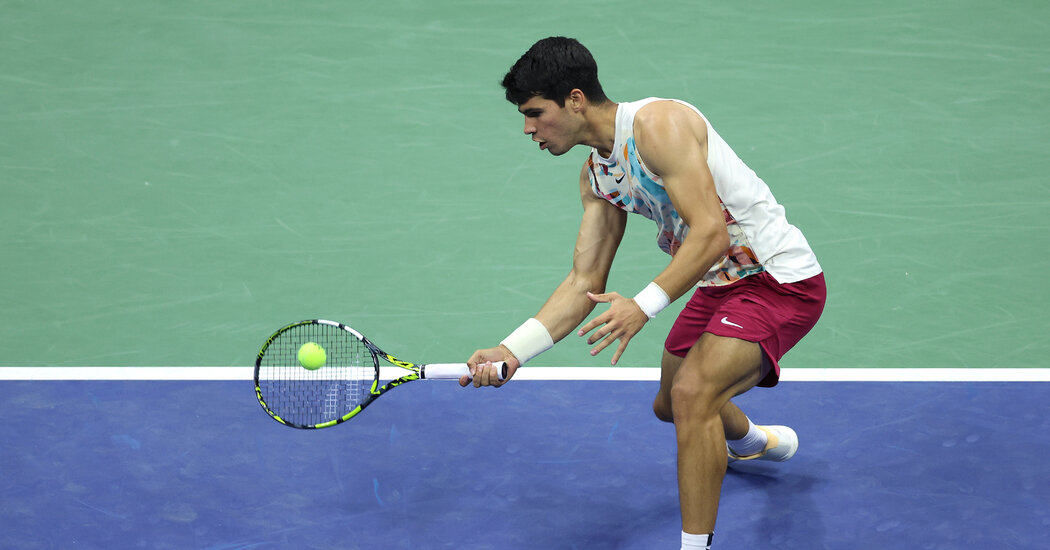
I thought I had seen it all on a tennis court until I watched Carlos Alcaraz at the U.S. Open on Monday.
No, I’m not talking about the speed and punch of his forehand. I’m talking about his audacious creativity: As Alcaraz worked his way into the net early in the match, Matteo Arnaldi lifted a lob over the Spaniard’s head. Alcaraz stopped, whirled his back to the net, jumped, and reached high to pull off a rare backhand overhead, which most pros attempt to hit with as powerful a snap as they can muster.
Alcaraz is not most pros. Instead of a snap, he purposefully deadened his stroke, sending the ball scooting off lightly and with a curve so it landed not far from the net.
A backhand, overhead drop shot winner in front of a packed house at Arthur Ashe Stadium? Who does that?
It was a small moment amid his 6-3, 6-3, 6-4 win, but it was beautiful, jaw-dropping and telling all at once.
In this, the age of power tennis — all those buff-bodied players, every racket now rebar stiff — Alcaraz is among the players resurrecting the softest, slowest change-of-pace stroke of them all: the drop shot, a.k.a. the marshmallow, a.k.a. the dropper.
Today’s players hit consistently harder than ever, as those who watched Alcaraz Monday would attest. But to win big — as in, emerging-victorious-at-Flushing-Meadows big — nuance is critical.
Increasingly, tennis’s top players are deploying drop shots, which until recently had fallen out of favor.
“Oh yes, we’re seeing it more now,” said Jose Higueras, who coached Michael Chang, Jim Courier and Roger Federer to major titles, as we watched a match from the stands lining Court 11 last week. He added: “You have to use the whole court, every part of it. These soft little shots do that. People think it’s defensive, but it’s actually very offensive.”
The dropper is the equivalent of a changeup pitch in baseball. It’s about disguise and surprise. Its finest practitioners — think Alcaraz, Novak Djokovic and Ons Jabeur in the women’s game — usually wind up as if they are about to hit a pounding groundstroke or a volley aimed at the baseline.
But that’s a ruse. The ball does not catapult off their strings. It pops off meekly, with a gentle lift that bends briefly before beginning a raindrop descent over the net.
Drop shots ask questions. “Hey, you, camping out there on the baseline, waiting for another two-handed backhand ripper. Did you expect me?”
“Can you change directions, churn out a sprint and catch me before I bounce twice?”
There was a time in the professional ranks — think of the era after John McEnroe’s dominance, all the way through the power game of the 1990s and early 2000s — when tennis’s marshmallow was an afterthought. When players did pull it out, they stuck to the percentages, seldom hitting it from the baseline or on big, high-tension points.
Change came as pro tennis’s top players increasingly drew from Europe, and particularly Spain, where they had grown up playing on clay, a surface that rewards a deft touch.
Rafael Nadal fully embraced the drop shot. Andy Murray, who trained in Spain as a junior, became a master.
But it was Higueras getting through to Federer that broke the dam. In 2008, when Federer hired the Spaniard to help take his game to a new level, Higueras immediately noticed that his new pupil rarely used the dropper, preferring to rely on his big forehand.
Higueras argued that adding softness to the mix would bring a finishing spice to Federer’s already stunning game. Mixing in more drop shots would force the competition to defend shots in front of the baseline — no more camping out at a distance.
Federer went on to win seven major titles after Higueras’s fix, including, in 2009, his only French Open.
After Federer adopted the changeup, a cascade of players on the men’s and women’s tours followed suit. Every year since, the drop shot’s use seems increasingly part of the game.
“There are players that use it out of desperation,” Grigor Dimitrov, the Bulgarian ATP Tour veteran, said last week. “There are players using it to change the rhythm. There are players using it to get a free point and players using it to get to the net.”
So, have we reached peak drop shot?
“I think we’re going to be seeing it more,” he said.
He’s not the only one. Martina Navratilova predicted that more pros would follow Alcaraz’s lead. “I think he will have an effect on the game,” she said in March, “in players really seeing, ‘I just cannot hit amazing forehands and backhands, I have to be an all-court player, I have to have the touch, I have to be brave, etc.’”
In every match, the No. 1-ranked Alcaraz will consistently wind up for a forehand, see his opponent bracing behind the baseline for a Mach 10 ball, and then, at the last nanosecond, slow his swing, cup the ball gently, and send it plopping across the net with the speed of a wayward butterfly.
Alcaraz has thrown the percentage playbook out the window. He will hit drop shots at any turn, whether he is stationed near the baseline or at the net, whether a match is in its early-stage lull or at its tensest moments.
When asked about the shot, Alcaraz recalled the joy of hitting it and befuddling his opponent. What goes through his mind after hitting the perfect dropper?
“It’s a great feeling,” he said, smiling broadly. “I mean, I feel like I’m going to do another one!”